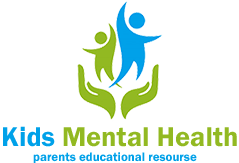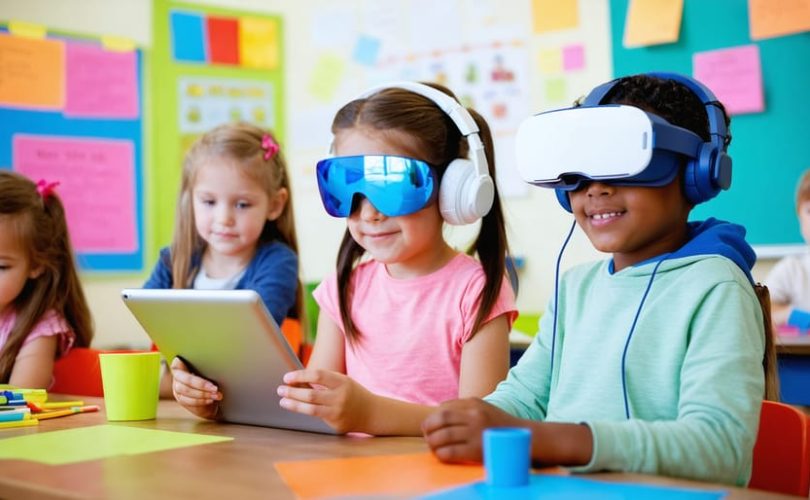Imagine a classroom where every student moves at their own perfect pace, using technology that adapts to their unique learning style. This isn’t a future fantasy – it’s happening right now in schools across the globe. Personalized learning technology is revolutionizing education by transforming the traditional one-size-fits-all approach into a dynamic, individualized experience that celebrates each student’s strengths and supports their challenges.
Today’s smart learning platforms use artificial intelligence and advanced analytics to create custom learning pathways, adjusting in real-time as students progress. These tools can identify when a child needs extra help with fractions, recognize when they’re ready to leap ahead in reading, or suggest alternative ways to grasp complex concepts – all while building confidence and maintaining engagement.
For parents and educators, this technological evolution means we can finally move beyond the limitations of traditional classroom settings. Whether your child is a visual learner who thrives on interactive diagrams, an auditory learner who benefits from spoken instructions, or a hands-on learner who needs virtual manipulatives, personalized learning technology ensures every student has the opportunity to succeed in their own unique way.
What makes this approach truly powerful is its ability to foster both academic excellence and emotional well-being, creating an environment where learning becomes a joy rather than a chore.
Understanding Your Child’s Learning Style
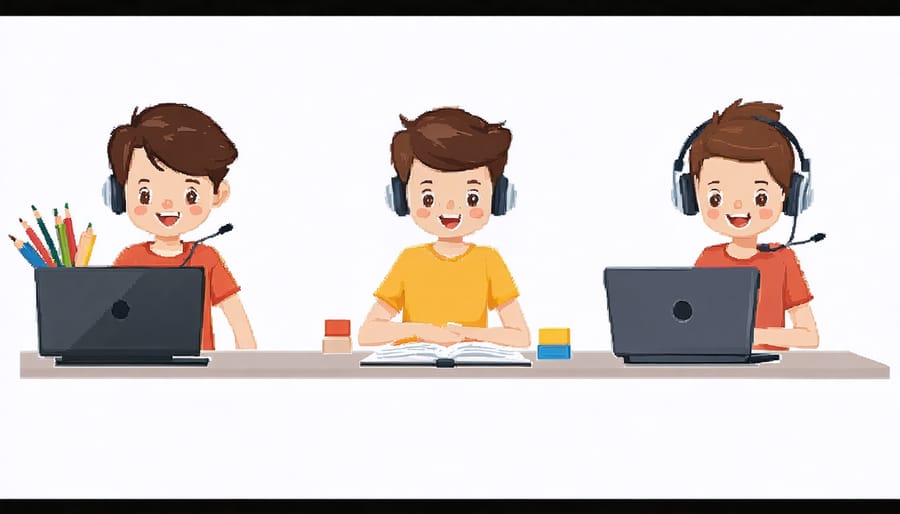
Visual, Auditory, and Kinesthetic Learning
Understanding different learning styles and preferences is key to creating an effective personalized learning environment. Each child processes information uniquely, typically favoring visual, auditory, or kinesthetic learning approaches – or a combination of these.
Visual learners thrive with tools like educational video platforms, mind-mapping software, and interactive infographics. Apps like BrainPOP and Khan Academy offer engaging animated content that brings concepts to life through colorful visuals and diagrams.
For auditory learners, text-to-speech tools, educational podcasts, and musical learning apps can make a significant difference. Audiobook platforms and voice recording tools allow these students to process information through their preferred listening and speaking methods.
Kinesthetic learners benefit from hands-on tech tools like touchscreen devices, virtual reality experiences, and interactive gaming platforms. Apps that encourage movement and physical interaction, such as coding robots or augmented reality educational games, help these students learn through doing.
By matching digital tools to your child’s natural learning style, you can create a more engaging and effective learning experience that builds confidence and maintains motivation.
Identifying Your Child’s Learning Preferences
Every child has unique ways of processing and retaining information. Some children learn best through visual aids like charts and videos, while others thrive when they can physically interact with learning materials. Pay attention to how your child naturally engages with their environment and responds to different teaching methods.
Visual learners often prefer picture books, diagrams, and watching educational videos. They might frequently say “show me” or draw pictures to explain their thoughts. Auditory learners, on the other hand, may enjoy listening to stories, music, and verbal instructions. These children often hum, talk to themselves while working, or remember song lyrics easily.
Kinesthetic learners need movement and hands-on experiences. Watch if your child fidgets during passive activities but excels when they can touch, build, or move while learning. Some children are also reading/writing learners who prefer taking notes and reading text to understand concepts.
Observe your child during both structured and unstructured activities. Do they remember information better after writing it down, hearing it, seeing it, or acting it out? These clues can help you choose the most effective technological tools and learning approaches for your child’s needs.
Smart Tools for Personalized Learning
Adaptive Learning Platforms
Today’s adaptive learning technologies are revolutionizing how students learn by creating truly personalized educational experiences. These intelligent platforms use sophisticated algorithms to understand each student’s learning pace, preferences, and challenges, adjusting content delivery in real-time.
Think of these platforms as digital tutors that grow alongside your child. When a student excels at certain concepts, the system automatically introduces more challenging material. Conversely, if a student struggles, it provides additional support and practice opportunities without causing frustration or embarrassment.
Sarah Thompson, a fifth-grade teacher in Boston, shares, “Since implementing adaptive learning in my classroom, I’ve seen remarkable improvements in student engagement. Children who previously felt left behind or bored now work at their own pace, building confidence along the way.”
These platforms typically feature:
– Continuous assessment of student progress
– Dynamic content adjustment based on performance
– Varied presentation methods to suit different learning styles
– Immediate feedback and encouragement
– Detailed progress reports for parents and teachers
The beauty of these systems lies in their ability to support emotional well-being while promoting academic growth. Students feel more in control of their learning journey, reducing anxiety and building self-esteem. As they experience success at their own pace, they develop a genuine love for learning that extends beyond the classroom.
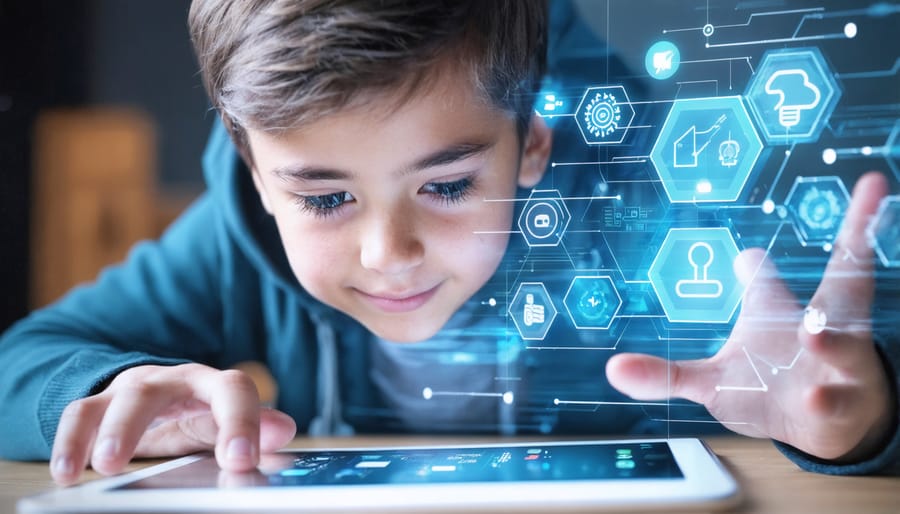
Interactive Learning Apps
Interactive learning apps have revolutionized the way children engage with educational content, making learning more enjoyable and effective. These digital tools adapt to each student’s pace and preferences, creating a truly personalized experience.
Popular apps like Duolingo and Khan Academy use adaptive algorithms to adjust difficulty levels based on student performance. When a child struggles with certain concepts, these apps provide additional practice and explanations. Conversely, if a student excels, they’re presented with more challenging material to maintain engagement and growth.
Many apps incorporate gamification elements that transform learning into an adventure. For instance, Prodigy Math makes mathematics exciting through a fantasy game world where solving problems helps players progress. Similarly, Reading Eggs uses colorful animations and rewards to keep young readers motivated.
For creative learners, apps like Scratch Jr introduce coding concepts through storytelling and animation. Students can express themselves while developing critical thinking skills. Meanwhile, apps like Newsela adjust reading levels of current events articles, allowing students to access age-appropriate content while building comprehension skills.
Parents and teachers report that these apps help maintain student interest and provide valuable feedback on progress. The immediate response and positive reinforcement offered by these tools can boost confidence and encourage independent learning. Remember to balance screen time with other activities and choose apps that align with your child’s learning goals and interests.
Digital Assessment Tools
Modern digital assessment tools have revolutionized how we track and support student progress in personalized learning environments. These innovative platforms go beyond traditional testing, offering real-time insights into each student’s learning journey while maintaining a supportive, stress-free atmosphere.
Many of these tools use adaptive technology to adjust questions based on student responses, ensuring that assessments are neither too challenging nor too easy. This approach helps maintain student confidence while providing accurate measurement of their understanding. As Sarah Thompson, an elementary school teacher in Boston, shares, “These tools help me identify exactly where each student needs support, allowing me to step in at just the right moment.”
The most effective digital assessment strategies incorporate multiple feedback methods, including visual progress trackers, personalized recommendations, and celebratory messages for achievements. These features help students stay motivated and engaged while giving parents and teachers valuable insights into learning patterns.
Popular assessment tools often include:
– Interactive quizzes that adapt to student responses
– Progress dashboards with visual learning maps
– Regular check-ins that measure emotional well-being alongside academic progress
– Automated feedback systems that offer immediate, constructive guidance
– Portfolio-based assessment options for creative work
Remember, the goal of these tools isn’t just to measure performance but to support each student’s unique learning journey while building confidence and maintaining emotional well-being.
Supporting Mental Well-being Through Tech-Based Learning
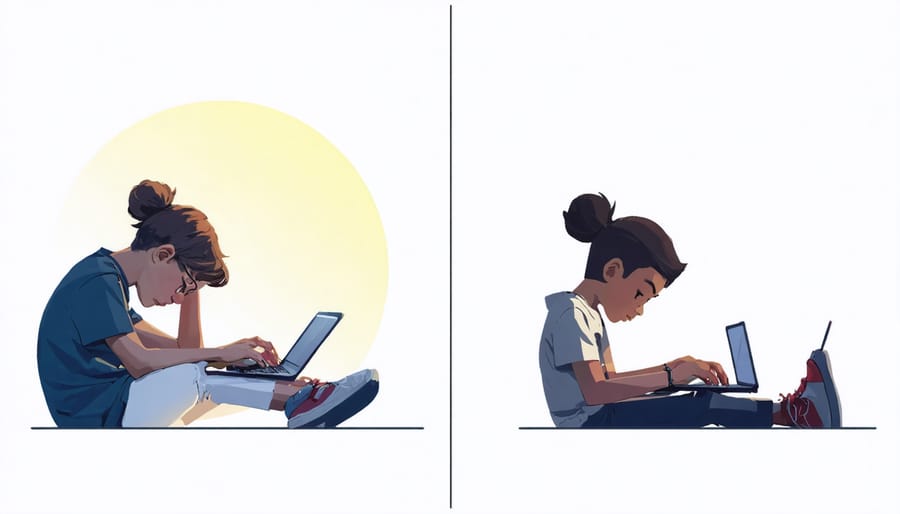
Reducing Learning Anxiety
Learning at one’s own pace is a crucial factor in reducing anxiety and promoting better academic stress management. When students can control their learning speed and approach, they feel more confident and less pressured to keep up with their peers.
Sarah Thompson, a school counselor with 15 years of experience, shares, “I’ve seen remarkable changes in students who switched to personalized learning platforms. They’re more relaxed, engaged, and willing to take on challenges because they know they won’t be rushed through difficult concepts.”
Personalized learning technology helps reduce anxiety in several ways:
– Students can review challenging material multiple times without feeling embarrassed
– Progress tracking shows small wins, building confidence gradually
– Immediate feedback prevents the buildup of confusion and frustration
– Flexible pacing allows for breaks when feeling overwhelmed
– Different learning formats accommodate various comfort levels
The emotional benefits extend beyond the classroom. Many parents report their children showing increased enthusiasm for learning at home and better overall well-being. As one parent notes, “My daughter used to dread math, but now she actually looks forward to her personalized lessons. The stress around homework has dramatically decreased.”
By removing the pressure to perform at a predetermined pace, personalized learning technology creates a more supportive and less anxiety-inducing educational environment.
Building Confidence Through Mastery
One of the most powerful aspects of personalized learning technology is its ability to build student confidence through measurable progress and achievable goals. When students can track their own advancement and celebrate small victories along the way, they develop a stronger sense of self-efficacy and academic confidence.
Digital learning platforms offer immediate feedback and visual representations of progress, helping students understand exactly where they stand and what they need to work on next. This transparency eliminates the uncertainty that often breeds anxiety in traditional learning environments. As Sarah Thompson, an elementary school teacher in Portland, explains, “When my students can see their growth in real-time, their entire attitude toward learning transforms.”
Achievement tracking features allow students to set personal goals and break them down into manageable steps. Whether it’s mastering multiplication tables or improving reading comprehension, these platforms celebrate progress at every level. This approach is particularly valuable for students who may struggle in traditional classroom settings, as it allows them to move at their own pace without feeling pressured to keep up with peers.
The confidence gained through these personalized achievements often extends beyond academic performance. Students develop better self-awareness, learning to recognize their strengths and areas for growth. This metacognitive skill becomes invaluable as they progress in their educational journey and face new challenges.
As we’ve explored throughout this article, personalized learning technology represents a transformative approach to education that puts students’ individual needs at the center of their learning journey. The benefits we’ve discussed are clear and compelling – from improved academic outcomes to enhanced student engagement and stronger emotional well-being.
By embracing these technological tools, we create learning environments where every child can thrive at their own pace and in their own way. Parents and teachers who have implemented personalized learning consistently report seeing increased confidence in their students, better retention of information, and a genuine enthusiasm for learning that traditional one-size-fits-all approaches often struggle to achieve.
Remember Sarah, the third-grade teacher we mentioned earlier, who saw her struggling students blossom after introducing adaptive learning software? Her experience mirrors countless others across the country who have witnessed the power of personalization firsthand.
The time to embrace personalized learning technology is now. Start small by introducing one or two tools in your classroom or home learning environment. Monitor your child’s progress, celebrate their achievements, and adjust strategies as needed. The beauty of personalized learning technology lies in its flexibility and adaptability – you can always modify your approach based on what works best for your learner.
The future of education is personal, adaptive, and technology-enhanced. While the transition might seem daunting at first, the potential benefits for our children’s academic success and emotional well-being make it worth the effort. With proper support and implementation, personalized learning technology can help create more confident, capable, and enthusiastic learners who are better prepared for the challenges of tomorrow.
Let’s work together to make education more inclusive, effective, and engaging for every child. After all, when we personalize learning, we’re not just improving academic outcomes – we’re investing in our children’s future success and well-being.
